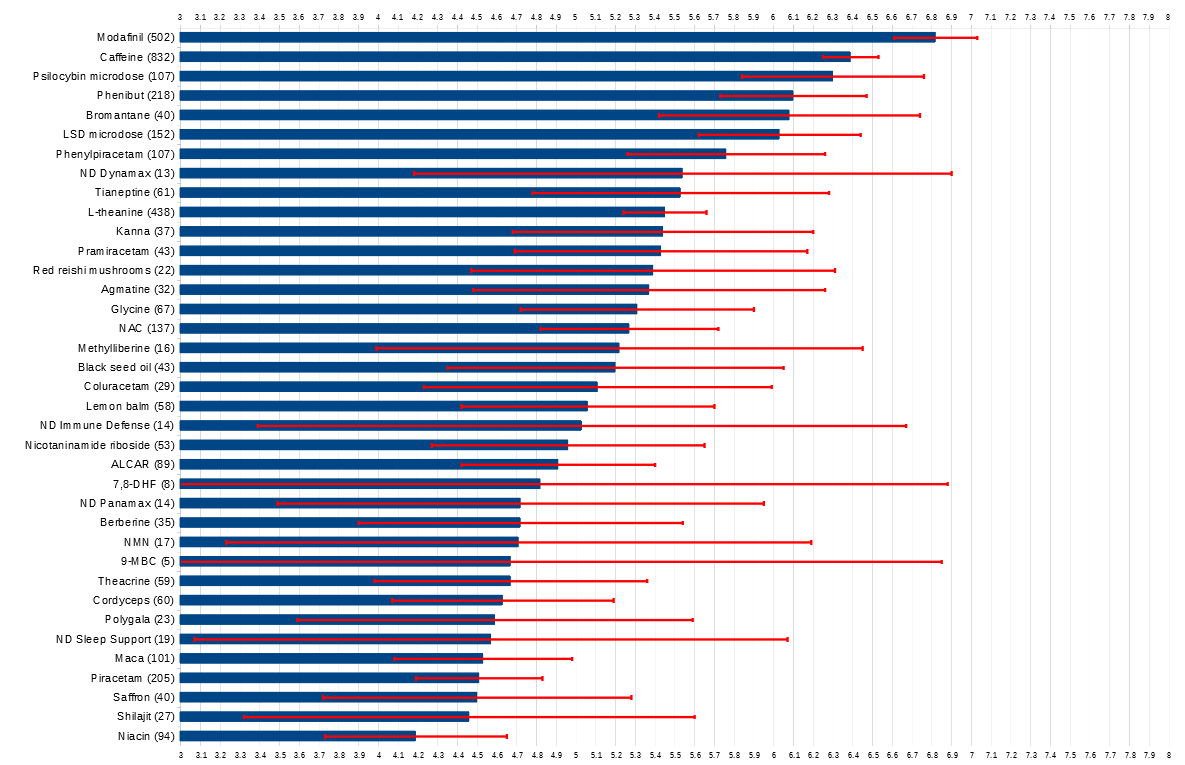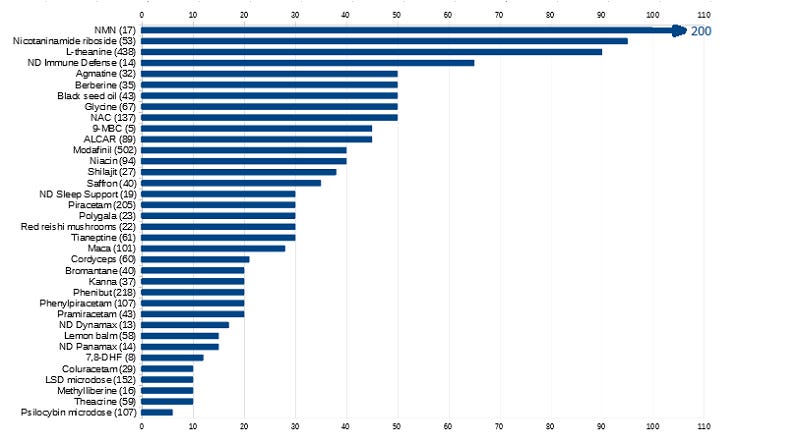Nootropics Survey 2020 Results
Thanks to the 852 of you who took the 2020 SSC nootropics survey.
I asked people to rate various nootropics on whether they “worked” or not, deliberately leaving the question kind of vague. This is using a broad definition of “nootropics” - any supplement or taken-outside-the-usual-medical-system drug that’s purported to have mental health effects. Most of the chemicals I asked about were supposed stimulants, anxiolytics, or antidepressants.
I’ll start with the headline results, then go into details:
 Nootropic (sample size in parentheses), adjusted mean rating 1-10 (note truncated axis!), and 95% confidence interval. Click to expand.
Nootropic (sample size in parentheses), adjusted mean rating 1-10 (note truncated axis!), and 95% confidence interval. Click to expand.
I tried to include a mix of common and well-studied nootropics as a baseline, plus some newer rarer substances nobody had looked into before. Predictably, the common substances got large sample sizes, and the rare substances got small ones. I excluded etifoxene, RGPU-95, and white jelly mushrooms from the graph because the sample was so small that the confidence interval would have covered the entire displayed range. A few substances on there are based off only 5 - 10 data points. I did a sort of ad hoc Bayesian adjustment where I assumed a prior of “average” for every substance and let the data try to push it away from that, which helped the numbers swing around a little less wildly.
Results were generally predictable and unexciting (with one exception I’ll get to soon). People thought stimulants worked better than non-stimulants, addictive substances better than non-addictive substances, and well-known mainstays better than new experimental chemicals. As on previous surveys, branded combination pills did worse than individual substances. For example, Nootropics Depot’s Dynamax, a mixture of several fancy types of caffeine and caffeine-like chemicals, did significantly worse than ordinary caffeine. Nootropics Depot has a lot of smart, careful people, so I don’t think they bungled the mixture. I think people just expect more out of branded products, and penalize them when they don’t perform better. Since all tests were open label, I have no way of knowing how much of the results were just expectation effects.
I also asked people how many times they took each nootropic. I’d hoped to get some measure of whether people thought it was helpful enough to keep taking it, but in retrospect it mostly tracked whether a nootropic works instantly vs. only after many months.
 Nootropics by median number of times taken per person.
Nootropics by median number of times taken per person.
The most-stuck-with nootropic was nicotinamide mononucleotide, a substance which is supposed to delay aging if you take it every day indefinitely.
Zembrin Is Interesting
Going back to the graph above, kanna (another name for the sceletium tortuosa plant), gets a respectable showing at 5.4. This is more impressive than it looks - I mentioned before that this was a combination of well-known mainstays and new substances I was actually interested in studying. Kanna was the highest-ranked of the new substances.
But I and many other people have had good results with Zembrin, a concentrated extract of kanna advertised for low mood and anxiety. So I asked respondents to specify whether their kanna was Zembrin or something else. Of 37 kanna users, 20 used Zembrin and 17 used something else. The subgroup who used Zembrin reported a mean effectiveness of 6.88, which beats out modafinil to make it highest on the list. After ad hoc Bayesian adjustment, it was 6.72, second only to modafinil as the second most effective nootropic on the list. This really excites me - I’ve felt like Zembrin was special for a while, and this is the only case of a newer nootropic on the survey beating the mainstays. And it’s a really unexpected victory. The top eight substances in the list are all either stimulants, addictive, illegal in the US, or all three. Zembrin is none of those, and it beats them all.
Based on these preliminary results, I wrote up a short page about Zembrin on my professional website, Lorien Psychiatry, and I asked anyone who planned to try it to preregister with me so I could ask them how it worked later. 29 people preregistered, of whom I was able to follow up with and get data from 22 after a few months. Of those 22, 16 (73%) said it seemed to help, 3 (14%) said it didn’t help, and another 3 (14%) couldn’t tell because they had to stop taking it due to side effects (two headaches, one case of “psychedelic closed-eye visuals”). Only 13 of the 22 people were willing to give it a score from 1-10 (people hate giving 1-10 scores!), and those averaged 5.9 (6.3 if we don’t count people who stopped it immediately due to side effects). That’s a little lower than on the survey, but this was a different population - for example, many of them in their answers specifically compared it to prescription antidepressants they’d taken, whereas the survey-takers were comparing it to nootropics. Although these findings are not very useful without a placebo control, they confirm that most people who take Zembrin at least subjectively find it helpful.
The small amount of research that’s been done on Zembrin suggests it works by inhibiting the serotonin transporter - ie it’s an SSRI. A South African plant being a natural SSRI is pretty cool. Does this explain the positive results?
I’m not sure. SSRIs are very effective for a lot of people. But Zembrin outperformed modafinil and phenibut on the survey. I have never heard even the most extreme fan of SSRIs (possibly me, honestly) claim people like them more than modafinil or phenibut. So this is either a bias (people think it’s cool to be taking a new experimental plant, but don’t like taking prescription medications with a bad reputation), or else Zembrin is either not an SSRI, or not just an SSRI. Of note, there are ways to prepare kanna (the plant Zembrin comes from) that make it kind of a recreational drug of abuse, though not a very addictive one. This suggests it has something more than just SSRI activity.
Also, most people (including me) report effects after only a few days taking Zembrin, which would be very early for an SSRI. Possibly the much-hyped SSRI+PDE4 augmentation effect is real, and Zembrin accomplishes it, but super low confidence in this.
I did ask respondents whether Zembrin caused them any sexual problems - something SSRIs are famous for doing. One person said yes, nine people said no, and ten people said they weren’t sure or hadn’t used it long enough to tell or something. Three people (12.5%) of the people who read about it on my website reported sexual side effects, but they’d read my essay on it (which included the possibility of sexual side effects), so this is a contaminated sample.
Sublingual Modafinil Is Not Very Interesting
I’d heard some rumors that modafinil worked better when taken sublingually - both because it absorbs better, and because it absorbs faster, meaning you’re not stuck in 24-36 hours of Sleeplessness Hell. I asked people if they’d tried this. 95% of modafinil users hadn’t. Of the 25 people who had, 13 said it was better, 12 said it was worse. They usually used doses between 50% and 100% of the oral dose. I asked for comments on this, and the only one I got was from someone who tried it once at 50% of the oral dose, and said it was terrible and lasted much longer than orally. Probably different people have different pharmacodynamics here, but don’t expect this to make it last less time.
Do Caffeine Alternatives Avoid Tolerance?
Theacrine is a purine alkaloid (ie close relative of caffeine) that gives the same kind of kick caffeine does. Some people have argued you should use it in place of caffeine because it doesn’t produce tolerance the same way caffeine does. I asked survey respondents if this was true for them. Most people, including most theacrine users, passed on this question and felt they didn’t have a really good sense of how fast tolerance built on it, but I got twelve brave souls willing to take a stand. 4 said they didn’t develop any tolerance, 7 said they got some tolerance but less than caffeine, and 1 said they got exactly as much tolerance as with caffeine. So maybe some weak support for the claim? Hard to say.
I also asked about methylliberine, a similar chemical. Here only two people would tell me anything, but both of them said it was tolerance-free.
I also asked about how people experience modafinil tolerance. Of the 291 people with an opinion, 37% said they developed tolerance after a few days, 23% after a few weeks, 8% after a few months or years, and 32% said they never experienced tolerance. Obviously people are all over the chart here, and I think that reflects a real difference - when I talk to people about this and try to qualitatively understand their experience, I get pretty much the same wide range of answers. The good news is that almost everyone who developed a tolerance says that it was reversible after a little while off of it. Of 196 people who answered this question, 68% found it fully reversible, 27% found it partially reversible, and only 5% said it didn’t reverse at all.
Overall Opinion Of Nootropics
I asked people how their experience experimenting with nootropics had been, and what effect it had on their lives. The results were:
18% strongly positive
61% modestly positive
15% no change
3% negative because they wasted time and money
2% negative because of side effects
Vendor Recommendations
I asked people to recommend good nootropics sources. Here are all the places with more than three recommendations:
3 recs: ModafinilXL, CosmicNootropic
4 recs: Liftmode
5 recs: Eufinil
6 recs: Science.bio
7 recs: BuyModa, LiftMode
48 recs: Nootropics Depot
I endorse the obvious conclusion of these rankings.
There was also a section to anti-recommend sites and companies you didn’t like. The only place to get two anti-recommendations was NootropicsSource, so stay away from them, I guess.
Thanks Again For Taking The Survey
Thanks again to the SSC community for taking this survey. No thanks to the broader nootropics community, who totally ignored this even though I tried to advertise it pretty heavily in a lot of nootropics subreddits and forums and chat rooms - 95% of respondents ended up being SSCers. I was disappointed in this because probably only a tiny fraction of SSCers use weird nootropics, whereas the nootropics community would be a data gold mine. If any of you are heavily involved in the nootropics community and have good ideas for how to get people outside this blog more involved next time, please let me know in the comments here or by email.